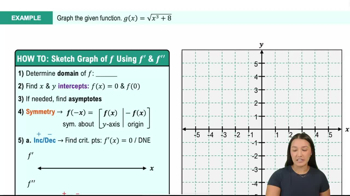Table of contents
- 0. Functions7h 52m
- Introduction to Functions16m
- Piecewise Functions10m
- Properties of Functions9m
- Common Functions1h 8m
- Transformations5m
- Combining Functions27m
- Exponent rules32m
- Exponential Functions28m
- Logarithmic Functions24m
- Properties of Logarithms34m
- Exponential & Logarithmic Equations35m
- Introduction to Trigonometric Functions38m
- Graphs of Trigonometric Functions44m
- Trigonometric Identities47m
- Inverse Trigonometric Functions48m
- 1. Limits and Continuity2h 2m
- 2. Intro to Derivatives1h 33m
- 3. Techniques of Differentiation3h 18m
- 4. Applications of Derivatives2h 38m
- 5. Graphical Applications of Derivatives6h 2m
- 6. Derivatives of Inverse, Exponential, & Logarithmic Functions2h 37m
- 7. Antiderivatives & Indefinite Integrals1h 26m
- 8. Definite Integrals4h 44m
- 9. Graphical Applications of Integrals2h 27m
- 10. Physics Applications of Integrals 2h 22m
5. Graphical Applications of Derivatives
Curve Sketching
Problem 4.3.102
Textbook Question
Designer functions Sketch the graph of a function f that is continuous on (-∞,∞) and satisfies the following sets of conditions.
f"(x) > 0 on (-∞,-2); f"(-2) = 0; f'(1) = 0; f"(2) = 0; f'(3) = 0; f"(x) > 0 on (4,∞)
 Verified step by step guidance
Verified step by step guidance1
Start by understanding the conditions given for the function f. The function is continuous on (-∞, ∞), which means there are no breaks, jumps, or holes in the graph.
Analyze the second derivative conditions: f''(x) > 0 on (-∞, -2) and f''(x) > 0 on (4, ∞). This indicates that the function is concave up in these intervals, meaning the graph is curving upwards.
Consider the points where the second derivative is zero: f''(-2) = 0 and f''(2) = 0. These points are likely inflection points where the concavity changes. At x = -2, the graph transitions from concave up to possibly concave down, and at x = 2, it transitions from concave down to concave up.
Examine the first derivative conditions: f'(1) = 0 and f'(3) = 0. These points are critical points where the slope of the tangent to the graph is zero, indicating potential local maxima or minima.
Combine all these insights to sketch the graph. Start with the intervals of concavity, mark the inflection points, and identify the critical points. Ensure the graph is continuous and reflects the changes in concavity and slope as described by the conditions.
 Verified video answer for a similar problem:
Verified video answer for a similar problem:This video solution was recommended by our tutors as helpful for the problem above
Video duration:
8mPlay a video:
Was this helpful?
Key Concepts
Here are the essential concepts you must grasp in order to answer the question correctly.
Second Derivative Test
The second derivative test is a method used to determine the concavity of a function and identify local extrema. If the second derivative, f''(x), is positive at a point, the function is concave up, indicating a local minimum. Conversely, if f''(x) is negative, the function is concave down, suggesting a local maximum. If f''(x) equals zero, the test is inconclusive, and further analysis is needed.
Recommended video:

The Second Derivative Test: Finding Local Extrema
Critical Points
Critical points occur where the first derivative of a function, f'(x), is zero or undefined. These points are essential for finding local maxima and minima, as they indicate where the function's slope changes. In the context of the given question, identifying critical points helps in sketching the graph and understanding the behavior of the function at specific intervals.
Recommended video:

Critical Points
Continuity and Differentiability
A function is continuous if there are no breaks, jumps, or holes in its graph, and it is differentiable if it has a defined derivative at all points in its domain. For the function f described in the question, continuity on (-∞, ∞) ensures that it can be analyzed using calculus techniques, while differentiability allows for the application of the first and second derivative tests to determine the function's behavior.
Recommended video:

Intro to Continuity

 11:41m
11:41mWatch next
Master Summary of Curve Sketching with a bite sized video explanation from Callie
Start learning




